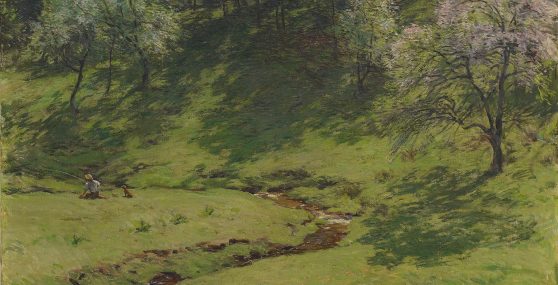National Museum of Asian Art Presents “Shifting Boundaries: Perspectives on American Landscapes”

May 07, 2024 | National Museum of Asian Art
Engaging a Multiplicity of Viewpoints, Exhibition Looks at Paintings of New England From a New Angle, Considers Human Impact, Indigenous Histories and Environmental Changes
The Smithsonian’s National Museum of Asian Art has announced “Shifting Boundaries: Perspectives on American Landscapes,” an exhibition featuring works by American painters such as William Metcalf, Dwight Tryon, Winslow Homer and Abbott Thayer who created profoundly beautiful views of the New England landscapes where they lived and worked. “Shifting Boundaries” looks at these works from a variety of viewpoints to explore what these paintings can tell the viewer about changes to the region. The landscapes become invitations to explore a century of human impact on land and water, the erasure of Indigenous histories and the environmental changes that are altering the New England today. “Shifting Boundaries” will open at the museum July 13 and remain on view until July 26, 2026.
The exhibition pilots a new mode of collaborative curatorial practice. The museum partnered with a group of experts in the field of environment and landscape to develop the themes for the exhibition, select works of art and write object labels. Lauren Brandes (Smithsonian Gardens), Dennis Chestnut (Ward 7 Resilience Hub Community Coalition), Jerome Foster II (Waic Up), Elizabeth James-Perry (Aquinnah Wampanoag artist and marine scientist), Lorette Picciano (Rural Coalition), Stephanie Toothman (National Park Service) and Melinda Whicher (Smithsonian Gardens) worked with the National Museum of Asian Art’s Lunder Curator of American Art Diana Greenwold, curatorial assistant Mary Mulcahy and interpretation specialists Liz Gardner and Amy Freesun. The group’s perspectives, drawn from their individual areas of professional expertise and their own personal experiences, allow people to see new details in these works of art and to document profound shifts in attitudes and practices about the environment over the past century.
These paintings largely depict the New England environment as timeless and static. “Shifting Boundaries” reveals, however, that the views these artists created of pasturelands in Massachusetts and of seascapes in Maine were transforming even as these artists recorded them. This reshaping has only accelerated in the century since Metcalf, Tryon, Homer and Thayer depicted them.
“As the National Museum of Asian Art enters our next 100 years, we are reflecting on our past and shaping our future with an emphasis on collaboration,” said Chase F. Robinson, the museum’s director. “We are sharing different perspectives in our galleries, experimenting with new approaches, examining object histories and proactively engaging with communities both locally and abroad. ‘Shifting Boundaries’ exemplifies all of this, showcasing what it means to be a museum in the 21st century.”
The National Museum of Asian Art’s collection includes over 1,700 works by artists from the United States. In addition to works by Metcalf, Tryon, Homer and Thayer, the museum has significant holdings of U.S. artists such as Thomas Dewing, John Singer Sargent, Childe Hassam and the nation’s largest collection of works by James McNeill Whistler—more than 1,000 in total, including the famed Peacock Room.
“Our collaborators worked with us from the inception of the project to craft a beautiful and important exhibition,” Greenwold said. “During our conversations, Mary, Liz, Amy and I served as guides and moderators for important and in-depth discussions about our country’s history and the role of a national museum in address challenging topics head on. Our collaborators’ brilliant selections and thoughtful labels transformed how I understood these works of art and I hope it will do the same for our visitors.”
Credits
This exhibition is made possible through support from the Terra Foundation for American Art.
About the National Museum of Asian Art
The Smithsonian’s National Museum of Asian Art is committed to preserving, exhibiting, researching and interpreting art in ways that deepen our collective understanding of Asia, the United States and the world. Home to more than 46,000 objects, the museum stewards one of North America’s largest and most comprehensive collections of Asian art, with works dating from antiquity to the present from China, Japan, Korea, South Asia, Southeast Asia and the Islamic world. Its rich holdings bring the arts of Asia into direct dialogue with an important collection of 19th- and early 20th-century art from the United States, providing an essential platform for creative collaboration and cultural exchange between the U.S., Asia and the Middle East.
Beginning with a 1906 gift that paved the way for the museum’s opening in 1923, the National Museum of Asian Art is a leading resource for visitors, students and scholars in the United States and internationally. Its galleries, laboratories, archives and library are located on the National Mall in Washington, D.C., and are part of the world’s largest museum complex, which typically reports more than 27 million visits each year. The museum is free and open to the public 364 days a year (closed Dec. 25), making its exhibitions, programs, learning opportunities and digital initiatives accessible to global audiences.
For more information, visit the museum’s website and follow updates on Instagram at @natasianart,
Twitter at @NatAsianArt and Facebook at @NatAsianArt.
For Press Inquiries
PressAsia@si.edu
Phone: (202) 633-0271
Fax: (202) 633-0043
Office of Marketing and Communications
National Museum of Asian Art
PO Box 37012, MRC 707
Washington, DC 20013-7012

